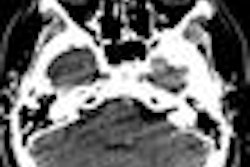A long-term analysis of nearly 22,000 young adults undergoing CT scans shows that they are at far greater risk of dying from underlying disease than from radiation-induced cancer, according to a study in Radiology.
Researchers from Massachusetts General Hospital found that among patients getting chest CT scans, 7.1% died during the study's 5.5-year follow-up period; during their lifetimes, this same population would see 0.1% of total deaths from radiation-induced cancer from CT scanning. The results were less dramatic for abdominal CT patients, with 3.9% of the patients dying during the follow-up period, with CT again contributing 0.1% to the total lifetime death rate (Radiology, February 5, 2013).
"The bottom line was that the models predict that over their lifetime, 0.1% in this group would die from a cancer that would have been caused by the CT scanning, and, in contrast, over a five-year period 4% to 7% are dying from their underlying illness," said lead investigator Dr. Susanna Lee, PhD, in an interview with AuntMinnie.com. "It sort of puts all of the issues into a more ... concrete context."
Rising CT volume
The huge volume of CT scans performed in the U.S. -- the number reached 80 million in 2010 -- drew the research group's attention when the study began in 2003.
The researchers' first efforts were aimed at patients who were scanned the most frequently, but it soon became clear that almost all of those patients faced grim prognoses, mostly for cancer, and would die before the first year's follow-up. So the study team decided to look at everyone who was scanned, ending up with a total of 21,945 patients.
In the context of life-threatening illness, most patients died before radiation-induced cancer could be a factor in their health. But most cancers occur in patients who are scanned just once or twice, who should therefore be prioritized in any study.
Patient data registries in three university-affiliated hospitals in the Boston metropolitan area were used to identify patients age 18 to 35 who underwent abdominopelvic CT or chest CT scans between 2003 and 2007.
Patients were grouped according to the body part scanned and the frequency of scanning. The investigators calculated CT risks based on the 2006 Biologic Effects of Ionizing Radiation VII (BEIR VII) report. The group found that the average effective dose was 7 mSv for chest CT scan and 10 mSv for an abdominopelvic CT scan.
During the five-year study period, a total of 16,851 chest scans and 24,112 abdominopelvic scans were performed, the group reported.
The researchers used the Social Security Death Index to determine deaths during a mean follow-up of 5.5 years, measured from the date of the patient's first scan. According to the results, 7.1% (575) chest CT patients and 3.9% (546) of 13,888 abdominal CT scan patients died, they reported.
The death rates compare with a predicted risk of dying from CT-induced cancer based on BEIR VII data that was calculated at 0.1% (five of 8,057 patients, p < 0.01) and 0.1% (eight of 12,472 patients, p < 0.01).
| Patient death rates | |||||
| Frequency of scanning | No. of patients | Percentage of patient deaths | Percentage of predicted CT cancer deaths | ||
| Chest CT | |||||
| 1-2 scans | 6,620 | 4.7 | 0 | ||
| 3-5 scans | 884 | 14.1 | 0.1 | ||
| 6-14 scans | 505 | 22.4 | 0.3 | ||
| > 15 scans | 48 | 50.0 | 0.6 | ||
| Overall | 8,057 | 7.1 | 0.1 | ||
| Abdominopelvic CT | |||||
| 1-2 scans | 11,905 | 2.8 | 0.1 | ||
| 3-5 scans | 1,334 | 10.3 | 0.2 | ||
| 6-14 scans | 606 | 14.5 | 0.4 | ||
| > 15 scans | 43 | 32.6 | 0.8 | ||
| Overall | 13,888 | 3.9 | 0.1 | ||
Early results presented last May showed only a four-year follow-up, and lacked specific the indications for CT scans, a key component for physicians advising patients about their need to undergo CT, Lee said. The new analysis of the indication for the scans shows that the patients being imaged were mostly very ill.
"By the time you're getting to the point in your physical evaluation where the doctors think you might need a scan, they're worried about something serious -- worried about a major motor vehicle accident, worried about an appendix that may perforate, worried that you have a cancer diagnosis and they want to make sure you're OK," Lee said.
The new data reveal that the most common chest CT indications are, in order of frequency, cancer, trauma, cardiac complaint, and respiratory complaints. For abdominopelvic CT, the most common indications are pain, cancer, trauma, urinary tract disease, bowel-related, or cardiopulmonary complaints. Analyzed by scan frequency, the most common diagnosis was cancer in all but those scanned only once or twice, the authors reported.
In chest CT patients, deaths in the short term outweighed the risk of long-term cancer death for the four most common exam indications. The same was true of the most common abdominopelvic indications except for urinary tract disease.
"In young patients undergoing body CT, the assumed risk of CT radiation cancer and resulting death was far outweighed by risk of intercurrent death presumably from their underlying morbidities," Lee and colleagues wrote. "This was true for all categories of scanning frequency and for patients undergoing either chest or abdominopelvic CT. Even patients without underlying cancer were much more likely to die in the near term."
Removing patients with a cancer diagnosis from the analysis left the remaining patients, who had only one or two chest CT scans, with a mortality risk of 3.6% during the follow-up period versus a risk of cancer death of 0.5% during their lifetimes. For abdominal scans, the mortality risk among those same patients was calculated at 1.9%, compared with a risk of radiation-induced cancer of 0.1%.
In a population-based analysis, "most of the radiation-induced cancers are predicted to occur in the very rarely scanned; however, at the individual level, the greatest risk is predicted in the frequently scanned in whom the dose is additive over multiple examinations," the authors wrote. "These results emphasize that radiologists should also focus radiation reduction efforts on patients who are very rarely scanned."
Better clinical context?
The results place the risk-benefit analysis of CT scans into a more clinically relevant context than past studies, Lee and colleagues wrote. Most models that estimate CT radiation-induced cancer assume that the patient is in perfect health and will remain alive for decades required for the predicted radiation-induced latency period. These assumptions will need to be reconsidered, they wrote.
"As a physician, me and many of my colleagues aren't requesting that these patients get scanned because they want something to do -- it's because they need the information to treat these patients for an illness," Lee said. "The patients ... not only have to deal with the lymphoma or the fractured spine, they have this concern that they're going to die of cancer because they have this CT scan. So there is a predicted possible risk but it needs to be taken in the context of all the other risks we take."
Moreover, CT risks are lower now that typical doses have been reduced to one-third to one-half of those used during the study period, Lee said. But the fact that most cancers occur in patients with only one to two scans because there are more of them means that dose-reduction strategies have been useful.
All the efforts from the Image Gently and Image Wisely campaigns, trying to reduce each exam to the lowest radiation dose, have turned out to be helping the infrequently scanned patients who have the greatest risk, Lee said. Vendors have really taken the low-dose message to heart as well, she said, automating dose reduction and making it easier for radiologists to optimize dose in daily practice.



















